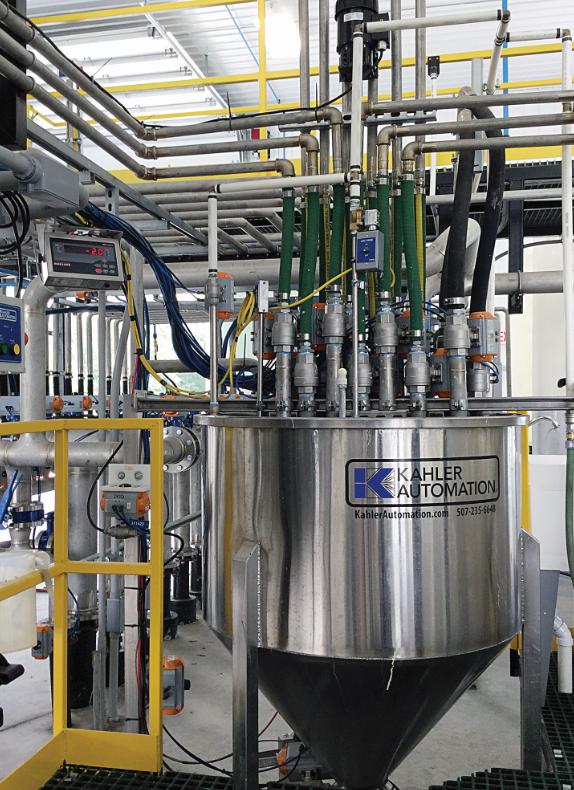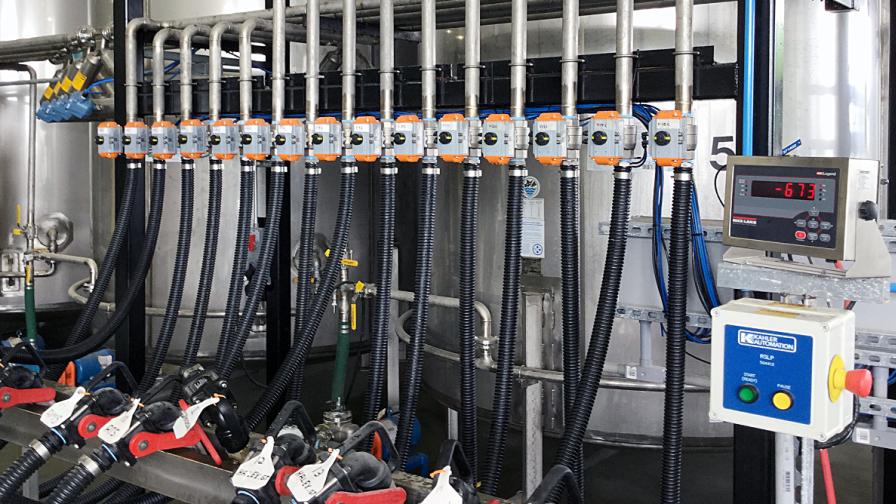An In-Plant Blending System is Critical to Ag Retail Success

A liquid mass flow system by Kahler Automation dispenses product in the load out line adjacent to the truck bay equipped with top and bottom fill.
When it comes to in-plant equipment and systems, it’s a world of automation.
A pair of industry veterans responded to questions from CropLife® magazine about how in-plant equipment and systems have evolved to give ag retailers another tool to help growers.
“In plant blending systems give a retailer the ability to produce a wide range of products and blends from a smaller set of bulk products,” says Mark Mohr Vice President of Sales and Marketing, Kahler Automation. “They are important for providing more and higher value products and services, while managing inventory and inputs. “They allow the retailer’s agronomy sales team to expand products and services into more and higher revenue offerings, while at the same time managing inventory and storage for efficient operations.”
Allowing these systems to handle tasks that once had to be done manually helps a retailer in numerous ways, says Dan Murray, President, ICS. “With continued industry consolidation and increased competition, retailers are turning to automation to maintain their competitive advantage with top-notch customer service. Automation improves customer responsiveness, lowers the time to the field, reduces human error, and streamlines the billing process. On the supply side, inventory levels are better tracked and monitored to make sure there’s enough product on hand to service customers while maintaining profitability.”
While it doesn’t guarantee success, retailers able to integrate these systems with their other offerings can certainly bring them closer to that end.

A weigh tank system by Kahler Automation excels at dispensing a large number of products precisely for small to medium inclusion rates in blends.
“A major trend is the need and ability handle more inputs, main ingredients, and additives to enhance either environmental or plant growth efficiency or both,” Mohr says. “Kahler Automation’s latest software lets you make product to inventory seamlessly, in addition to load out. A facility that has been blending products directly to loadout can easily upgrade their Kahler Plant Supervisor PSX software with the PSX Manufacturing module to make product to inventory. This is important for retailers who are upgrading facilities to serve as hubs to more plants, serving a larger customer base or wholesale customers. This is especially helpful for liquid blenders where the blend or agitation time may be longer than a loadout bay should be tied up. It’s all about being efficient and ready for peak season with accurate blends and documented inventory without manual paperwork.”
As software solutions change around a retailer’s operations, the in-plant system must be able to adapt.
“ICS has always taken a flexible approach to integrating with back-office and agronomy software,” Murray says. “However, recently ICS has taken the initiative to create and promote interface standards across the industry. Our lead programmer chairs a committee that’s working to standardize interfaces between various industry software solutions. By standardizing, more information will be able to be passed back and forth between software solutions. It also means new features added to ICS or the agronomy/ERP software will be interfaced more easily.”
As anyone who uses a computer regularly knows, software is revised regularly. While the hardware might not be updated as often, it doesn’t mean there haven’t been changes to the more permanent part of the solution.
“In recent years, high-speed Internet has become much more accessible in rural areas,” Murray says. “This has allowed ICS to deploy a host of new features: improved multi-location management, online support, and web-based updates.”
Mohr touts a few other additions to the latest offerings.
“Two general trends are more products as inputs and, especially in irrigated regions, blended liquid products going out in totes or something other than a bulk,” Mohr says. “The equipment to fill, and then track, manage, and inventory totes in a facility has grown at the same time labor to do all that manually has been increasingly hard to retain. Kahler’s Containers module and software for filling and tracking containers is on the uptrend as a result.
“Whenever a product is added or changed it makes sense to review the equipment’s capabilities,” Mohr continues. “That can be as simple as verifying the meter or scale ranges are appropriate for the dose, or it can be more complex like adding product valves, meters, pumps, or scales for another product. Kahler Automation’s newest software includes ongoing access to updates and support, so although software updates are very important, they are easy.”
Not only are these systems easier to use, they can be controlled through a growing number of devices.
“Thanks to tablets and other mobile devices, ICS is becoming more software-based,” Murray says. “ICS can control plant equipment remotely at a safe distance. Being increasingly more software-based allows ICS to push out updates and add new features without re-engineering the entire plant. Finally, if the tablet or mobile device breaks, it’s much more easily replaced than a custom box.
“For many applications, control boxes continue to make the most sense,” Murray continues. “ICS control boxes use industry-standard components. If something breaks, it can be repaired quickly using easily sourced parts, preventing downtime.”
Challenges to Implementation
“The operations team needs to understand compatibilities of products being blended in liquid systems, and how to manage efficient change over from products,” Mohr says. “And the equipment configuration needs to support avoiding cross products. An increasing number of systems Kahler is designing use sensors to help know product levels, gate and valve positions to manage this. Depending on the products being blended and made, avoiding cross product may mean grouping batches of certain product groups to be made, or it may mean having two systems if in-season demand requires simultaneously handing incompatible products.”
As the solutions these products handle become more sophisticated, the systems themselves must be “taught” how the manage the complex array of products and how they’re brought together.
“Kahler Automation has been making liquid weigh tank and meter-based blending systems and automating the industry’s dry and liquid blending equipment for over 30 years,” Mohr says. “The latest upgrades are about handling complex recipes and an ever-increasing number of inputs efficiently. What is new is how easy it is to have the right software that is regularly updated and supported 24/7 for managing these systems. Kahler’s latest software is highly connected with ERP and agronomy software so the operations team has what’s needed to easily handle the complex recipes, accurate inventory, easily handling orders and tickets with the ERP and agronomy systems and keeping everything legal-for-trade. Kahler’s Terminal Management TMX and Plant Supervisor PSX software is modular, supported, and updated to allow simple operation where needed and is expandable to handle complex situations easily.”







